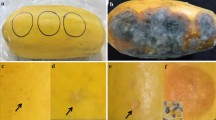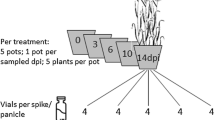Abstract
The structures and manner with which Pseudocercospora macadamiae penetrates, colonises and proliferates from the pericarp of macadamia fruit was studied using scanning electron microscopy and fluorescence light microscopy. Germ tubes arising from conidia penetrated open stomata within 20 h of inoculation, without observation of specialised infection structures such as appressoria. Colonisation of the pericarp was intercellular, without observation of specialised intracellular infection structures such as haustoria, and was complete from the epidermis to the mesocarp. The fungus proliferated at the epidermis by the formation of conidiophores and conidia on substomatal and protuberant subepidermal stromata. These structures were not observed on the mesocarp surface. The onset of visual husk spot symptoms coincided with an increase in pathogen biomass on the pericarp surface. The progression of symptoms from tan-coloured spots to larger red-brown lesions coincided with the production of conidiophores from substomatal and protuberant subepidermal stromata. The darker the colour of the husk spot lesion, the more frequently protuberant subepidermal stromata were observed. These findings are discussed in the context of observation of other cercosporoid fungi.
Similar content being viewed by others
References
Akinsanmi OA, Miles AK, Drenth A (2007) Timing of fungicide application for control of husk spot caused by Pseudocercospora macadamiae in Macadamia. Plant Disease 91, 1675–1681. doi: 10.1094/PDIS-91-12-1675
Babu AM, Kumar V, Govindaiah (2002) Surface ultrastructural studies on the infection process of Pseudocercospora mori causing grey leaf spot disease in mulberry. Mycological Research 106, 938–945. doi: 10.1017/ S095375620200624X
Babu AM, Philip T, Kumar V (2007) Development of the leaf spot fungus, Cercospora ricinella, on castor leaf — an SEM account. Journal of Phytopathology 155, 426–430. doi: 10.1111/j.1439-0434. 2007.01253.x
Baxter JW (1956) Cercospora black stem of alfalfa. Phytopathology 46, 398–400.
Beckman PM, Payne GA (1982) External growth, penetration, and development of Cercospora zeae-maydis in corn leaves. Phytopathology 72, 810–815.
Beilharz V, Mayers PE, Pascoe IG (2003) Pseudocercospora macadamiae sp. nov., the cause of husk spot of macadamia. Australasian Plant Pathology 32, 279–282. doi: 10.1071/AP03018
Bell HFD, Bell MA, Bell DJD (1988) Macadamia integrifolia × tetraphylla. Plant Varieties Journal 1, 7–12.
Borges Neto CR, Silveira EB, Mello SCM, Fontes EMG (1998) Scanning electron microscopy of the infection process of Cercospora caricis on purple nutsedge. Fitopatologia Brasileira 23, 169–172.
Clark JSC, Spencer-Phillips PTN (1993) Accumulation of photoassimilate by Peronospora viciae (Berk.) Casp. and leaves of Pisum sativum L.: evidence for nutrient uptake via intercellular hyphae. The New Phytologist 124, 107–119. doi: 10.1111/j.1469-8137.1993.tb03802.x
Coates LM, Muirhead IF, Irwin JAG, Gowanlock DH (1993) Initial infection processes by Colletotrichum gloeosporioides on avocado fruit. Mycological Research 97, 1363–1370.
Francis WD (1928) The anatomy of the Australia bush nut (Macadamia ternifolia). Proceedings of the Royal Society of Queensland 39, 43–53.
Gupta VP, Tewary SK, Govindaiah Bajpai AK, Datta RK (1995) Observations on the surface ultrastructure of conidial stage of Cercospora moricola and its infection process in mulberry. Sericologia 35, 123–128.
Hartung ME, Storey WB (1939) The development of the fruit of Macadamia ternifolia. Journal of Agricultural Research 59, 397–406.
Hodges CS, Haasis FA (1962) Etiology of cercospora leaf spot of Magnolia. Mycologia 54, 448–454. doi: 10.2307/3756576
Ito PJ (1980) Effect of style removal on fruit set in macadamia. HortScience 15, 520.
Johnston PR, Sutherland PW, Joshee S (2006) Visualising endophytic fungi within leaves by detection of (1–3)-β-D-glucans in fungal cell walls. The Mycologist 20, 159–162. doi: 10.1016/j.mycol.2006.10.003
Judd RW, Peterson JL (1974) Cercospora omphakodes infection and disease development in Phlox divaricata. Phytopathology 64, 1108–1111.
Kumar V, Gupta VP, Babu AM, Mishra RK, Thiagarajan V, Datta RK (2001) Surface ultrastructural studies on penetration and infection process of Colletotrichum gloeosporioides on mulberry leaf causing black spot disease. Journal of Phytopathology 149, 629–633. doi: 10.1046/ j.1439-0434.2001.00684.x
Latham DH (1934) Life history of a Cercospora leaf-spot fungus of Cowpea. Mycologia 26, 516–527. doi: 10.2307/3754182
Lemoine MC, Gollotte A, Gianinazzi-Pearson V (1995) Localization of β (1–3) glucan in walls of the endomycorrhizal fungi Glomus mosseae (Nicol.&Gerd.) Gerd.&Trappe and Acaulospora laevis Gerd.&Trappe during colonization of host roots. The New Phytologist 129, 97–105. doi: 10.1111/j.1469-8137.1995.tb03013.x
Mayers PE (1998) Epidemiology and control of husk spot of macadamia. Australian Macadamia Society Ltd News Bulletin 25, 59–64.
McKenzie HA, Dawson RMC (1969) pH, buffers and physiological media. In ‘Data for biochemical research’. 2nd edn. (Eds RMC Dawson, DC Elliott, WH Elliott, KM Jones) pp. 475–508. (Clarendon Press: Oxford, UK)
Mondal SN, Timmer LW (2006) Relationship of the severity of citrus greasy spot, caused by Mycosphaerella citri, to ascospore dose, epiphytic growth, leaf age, and fungicide timing. Plant Disease 90, 220–224. doi: 10.1094/PD-90-0220
Price TV, Munro PE (1978) Pseudocercospora psophocarpi on winged bean in Papua New Guinea. Transactions of the British Mycological Society 70, 47–55.
Rathaiah Y (1976) Infection of sugarbeet by Cercospora beticola in relation to stomatal condition. Phytopathology 66, 737–740.
Sisterna M, Ronco L (2005) Occurrence of grapevine leaf spot caused by Pseudocercospora vitis in Argentina. Plant Pathology 54, 247. doi: 10.1111/j.1365-3059.2005.01135.x
Strohschen B (1986) Contributions to the biology of useful plants. 4. Anatomical studies of fruit development and fruit classification of Macadamia nut (Macadamia integrifolia Maiden and Betche). Angewandte Botanik 60, 239–247.
Sutherland PW, Hallet IC, MacRae E, Fischer M, Redgwell RJ (2004) Cytochemistry and immunolocalisation of polysaccharides and proteoglycans in the endosperm of green Arabica coffee beans. Protoplasma 223, 203–211. doi: 10.1007/s00709-004-0036-8
Tetlow IJ, Farrar JF (1993) Apoplastic sugar concentration and pH in barley leaves infected with brown rust. Journal of Experimental Botany 44, 929–936. doi: 10.1093/jxb/44.5.929
Thomas HR (1943) Cercospora blight of carrot. Phytopathology 33, 114–125.
Urata U (1954) Pollination requirements of macadamia. Hawaii Agricultural Experiment Station Technical Bulletin 22, 5–40.
Whiteside JO (1972) Histopathology of citrus greasy spot and identification of the causal fungus. Phytopathology 62, 260–263.
Woodroof NC (1933) Two leaf spots of the Peanut (Arachis hypogaea L.). Phytopathology 23, 627–640.
Woodward RC (1932) Cercospora fabae Pantrey, on field beans. Transactions of the British Mycological Society 17, 195–202.
Wright J (1993) Investigations contributing to the knowledge of pathogenicity and genetic variability of the macadamia husk spot pathogen Pseudocercospora sp. Honours thesis, University of Queensland.
Author information
Authors and Affiliations
Corresponding author
Rights and permissions
About this article
Cite this article
Miles, A.K., Akinsanmi, O.A., Sutherland, P.W. et al. Infection, colonisation and sporulation by Pseudocercospora macadamiae on macadamia fruit. Australasian Plant Pathology 38, 36–43 (2009). https://doi.org/10.1071/AP08074
Received:
Accepted:
Issue Date:
DOI: https://doi.org/10.1071/AP08074




